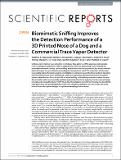| dc.contributor.author | Staymates, Matthew E. | |
| dc.contributor.author | MacCrehan, William A. | |
| dc.contributor.author | Staymates, Jessica L. | |
| dc.contributor.author | Gillen, Greg J. | |
| dc.contributor.author | Craven, Brent A. | |
| dc.contributor.author | Kunz, Roderick R | |
| dc.contributor.author | Mendum, Thomas H.e. | |
| dc.contributor.author | Ong, Ta-Hsuan | |
| dc.contributor.author | Geurtsen, Geoffrey P. | |
| dc.date.accessioned | 2017-04-27T14:30:03Z | |
| dc.date.available | 2017-04-27T14:30:03Z | |
| dc.date.issued | 2016-12 | |
| dc.date.submitted | 2016-08 | |
| dc.identifier.issn | 2045-2322 | |
| dc.identifier.uri | http://hdl.handle.net/1721.1/108446 | |
| dc.description.abstract | Unlike current chemical trace detection technology, dogs actively sniff to acquire an odor sample. Flow visualization experiments with an anatomically-similar 3D printed dog’s nose revealed the external aerodynamics during canine sniffing, where ventral-laterally expired air jets entrain odorant-laden air toward the nose, thereby extending the “aerodynamic reach” for inspiration of otherwise inaccessible odors. Chemical sampling and detection experiments quantified two modes of operation with the artificial nose-active sniffing and continuous inspiration-and demonstrated an increase in odorant detection by a factor of up to 18 for active sniffing. A 16-fold improvement in detection was demonstrated with a commercially-available explosives detector by applying this bio-inspired design principle and making the device “sniff” like a dog. These lessons learned from the dog may benefit the next-generation of vapor samplers for explosives, narcotics, pathogens, or even cancer, and could inform future bio-inspired designs for optimized sampling of odor plumes. | en_US |
| dc.description.sponsorship | United States. Department of Homeland Security. Advanced Research Projects Agency (Interagency Agreement HSHQPM-13-X-00107) | en_US |
| dc.description.sponsorship | United States. Air Force (Contract FA8721-05-C-0002) | en_US |
| dc.description.sponsorship | United States. Air Force (Contract FA8702-15-D-0001) | en_US |
| dc.language.iso | en_US | |
| dc.publisher | Nature Publishing Group | en_US |
| dc.relation.isversionof | http://dx.doi.org/10.1038/srep36876 | en_US |
| dc.rights | Creative Commons Attribution 4.0 International License | en_US |
| dc.rights.uri | http://creativecommons.org/licenses/by/4.0/ | en_US |
| dc.source | Nature | en_US |
| dc.title | Biomimetic Sniffing Improves the Detection Performance of a 3D Printed Nose of a Dog and a Commercial Trace Vapor Detector | en_US |
| dc.type | Article | en_US |
| dc.identifier.citation | Staymates, Matthew E. et al. “Biomimetic Sniffing Improves the Detection Performance of a 3D Printed Nose of a Dog and a Commercial Trace Vapor Detector.” Scientific Reports 6.1 (2016): n. pag. | en_US |
| dc.contributor.department | Lincoln Laboratory | en_US |
| dc.contributor.mitauthor | Kunz, Roderick R | |
| dc.contributor.mitauthor | Mendum, Thomas H.e. | |
| dc.contributor.mitauthor | Ong, Ta-Hsuan | |
| dc.contributor.mitauthor | Geurtsen, Geoffrey P. | |
| dc.relation.journal | Scientific Reports | en_US |
| dc.eprint.version | Final published version | en_US |
| dc.type.uri | http://purl.org/eprint/type/JournalArticle | en_US |
| eprint.status | http://purl.org/eprint/status/PeerReviewed | en_US |
| dspace.orderedauthors | Staymates, Matthew E.; MacCrehan, William A.; Staymates, Jessica L.; Kunz, Roderick R.; Mendum, Thomas; Ong, Ta-Hsuan; Geurtsen, Geoffrey; Gillen, Greg J.; Craven, Brent A. | en_US |
| dspace.embargo.terms | N | en_US |
| mit.license | PUBLISHER_CC | en_US |
